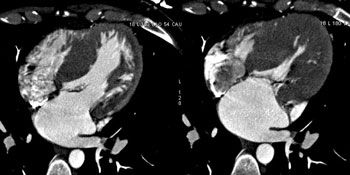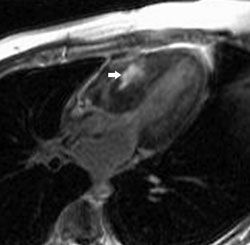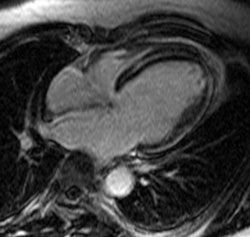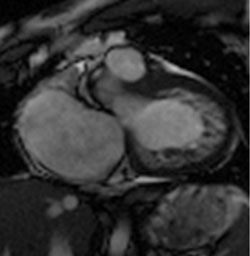Imaging’s role increases in diagnosis of cardiomyopathies
They are a major cause of progressive heart failure and death, but cardiomyopathies can be tough to spot for clinicians, and missed cases can have fatal consequences. During an ECR special focus session on Friday afternoon, expert speakers reviewed the use of imaging for diagnosing the mysterious condition and for mastering its many faces.
They are a major cause of progressive heart failure and death, but cardiomyopathies can be tough to spot for clinicians, and missed cases can have fatal consequences. During an ECR special focus session on Friday afternoon, expert speakers reviewed the use of imaging for diagnosing the mysterious condition and for mastering its many faces.
Much of cardiac imaging practice is focused on characterization of coronary artery disease, and radiologists may be less familiar with primary cardiomyopathies, which are defined as diseases of the myocardium of unknown origin and are associated with cardiac dysfunction.
Conventional wisdom used to hold that cardiomyopathies were not very common, but imaging advances in MR and CT have enabled detection of more cases and helped uncover a heterogeneous group of diseases. Cardiomyopathies occur in about one in 5000 people, but the incidence can be much more or less common, depending on the disease type.
“Most radiologists know cardiomyopathies exist, but the majority do not know the details of modern classification and peculiarities of different types of cardiomyopathies,” said Prof. Valentin Sinitsyn, chair of radiology at Moscow State University’s Cardiology Research Complex, who began the session with an introduction to cardiomyopathy, including its history.
Five major types have been identified: dilated, restrictive, hypertrophic, arrythymogenic right ventricular, and “unclassified,” which includes several forms that are less commonly reported. Echocardiography has been the main imaging technique for diagnosis of cardiomyopathy and is still widely used, but MRI has become increasingly valuable in differentiating it from other conditions, such as heart attack and congenital heart disease.
Depending on the disease type, patients may present with a variety of symptoms, including breathlessness, exercise intolerance, and chest pain. Imaging is performed by both cardiologists and radiologists, and many centers are moving toward multidisciplinary assessment to achieve the best outcomes for patients.
Some high-profile, tragic cases of missed diagnoses have raised awareness about cardiomyopathies in recent years. In 2008, a 19-year-old Russian hockey player named Alexei Cherepanov collapsed during a game in Moscow and later died of heart failure. He suffered from the hypertrophic form of cardiomyopathy, characterized by enlargement of the muscle mass of the left ventricle.
Increasingly, hypertrophic cardiomyopathies are suspected in cases of sudden death, particularly in men. Hypertrophic cardiomyopathy is thought to be the most common inherited heart defect, yet most people are unaware of it. It is also the leading cause of sudden cardiac death in young people, including trained athletes.
Meanwhile, every year, more of the “unclassified” or rare types are reported in the literature, which presents challenges for classification, according to Sinitsyn.
During the focus session, Dr. Jonathan Dodd, a consultant radiologist at St. Vincent’s University Hospital in Dublin, reviewed the rarer forms and demonstrated their appearance on MRI. Several recent technological innovations in cardiac MRI are useful in evaluating cardiomyopathies, including vector ECG gating, rapid k-space sampling, and parallel imaging with surface coils. Gadolinium-enhanced MRI can be used to further evaluate changes within the myocardium, and it can aid in characterizing cardiomyopathies.
“The role of cardiac MRI as an imaging modality for characterizing cardiomyopathy is expanding markedly,” Dodd said. “We used to think cardiomyopathies were uncommon. But as use of cardiac MR and other imaging modalities increases, several types are being diagnosed with increasing frequency.”
For example, reports of Takotsubo cardiomyopathy, initially described in Japan in the early 1990s, have been cropping up in Europe and North America. This type of cardiomyopathy is also called “broken-heart syndrome” because it is commonly triggered by emotional stress. But based on clinical symptoms, it may be hard to tell the rare broken-heart syndrome from a run-of-the-mill heart attack or other common pathologies. The syndrome is known to mimic myocardial infarction; patients present with acute chest pain, arrhythmias, and, in the worst cases, cardiogenic shock.



Cardiac MRI can provide exquisite depiction of the telltale apical ballooning characteristics of broken-heart syndrome. In fact, cardiac MRI has become the reference standard for noninvasively depicting global and regional myocardial motion abnormalities. On gadolinium-enhanced MRI, late myocardial hyperenhancement is typically absent in Takotsubo cases. This helps differentiate the condition from myocardial infarction and myocarditis, which normally do show patterns of late hyperenhancement.
Treatment for each of these conditions is completely different, so the cardiac MRI findings have a direct impact on clinical management decisions, Dodd said.
Another unclassified type featured during the session is isolated left-ventricular noncompacted syndrome, which is characterized on imaging by an increased ratio of noncompacted to compacted myocardium. Clinical presentation varies widely for this type of cardiomyopathy. Some patients may be relatively asymptomatic and others will develop progressive heart failure, arrhythmias, and thromboembolic events. Cardiac MRI is particularly useful for evaluating the left ventricular apex and lateral wall, which may sometimes be difficult to visualize with echocardiography, he said.

The Reading Room Podcast: Current Perspectives on the Updated Appropriate Use Criteria for Brain PET
March 18th 2025In a new podcast, Satoshi Minoshima, M.D., Ph.D., and James Williams, Ph.D., share their insights on the recently updated appropriate use criteria for amyloid PET and tau PET in patients with mild cognitive impairment.
Meta-Analysis Shows Merits of AI with CTA Detection of Coronary Artery Stenosis and Calcified Plaque
April 16th 2025Artificial intelligence demonstrated higher AUC, sensitivity, and specificity than radiologists for detecting coronary artery stenosis > 50 percent on computed tomography angiography (CTA), according to a new 17-study meta-analysis.